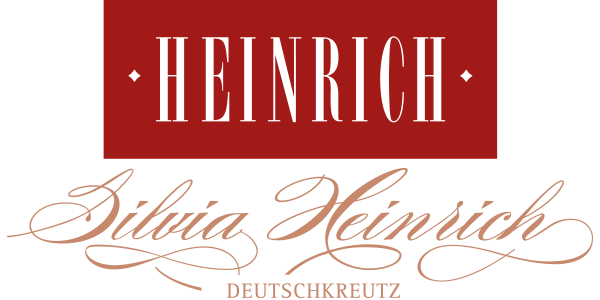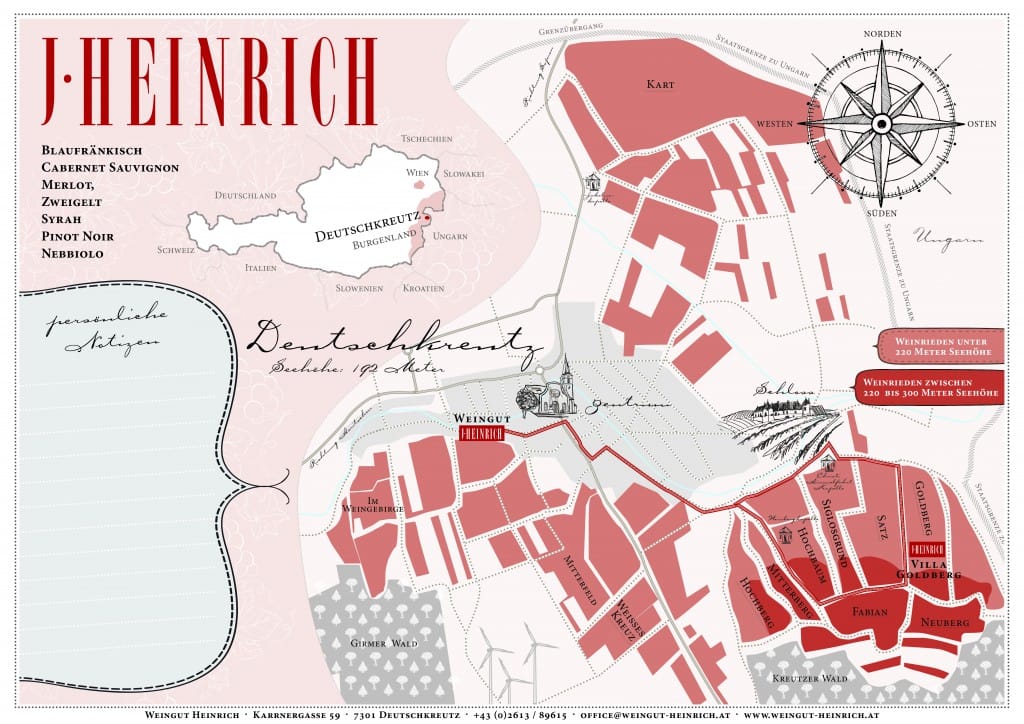“Vineyards are like children to me.”
„Vineyards are like children to me. And like children, I want to accompany and support them and do my best for them. This is the only way they can grow, develop their personality and reach their full potential.”
Silvia Heinrich
The locations
Altes Weingebirge: includes Goldberg, Hochberg, Siglos, Fabian, Satz, Neuberg and Mitterberg. Fertile clay soils with a high proportion of lime. Our Blaufränkisch, Zweigelt, Merlot and Syrah varieties thrive here under ideal conditions.
Weisses Kreuz: Gravelly barren soil. Mineral and calcareous. Ideal for our diva Pinot Noir.
Kart: Sandy stony soils with strong sunlight. A “hot spot” for our Cabernet Sauvignon.
The Soil
Our deep soils have a large water storage capacity, which has a very positive effect on the quality of our vines, especially in dry years. Calcareous soils with loamy, sandy and gravelly parts predominate.
The Climate
Our vineyards are protected from the cold winds by the Bucklige Welt in the west, the Ödenburger Mountains in the north and the Günser Mountains in the south. Open to the east, warm and dry wind can flow in unhindered from the Pannonian lowlands. The Neusiedlersee plays an important role in regulating temperature. Cold, snowy winters and hot, dry summers are typical of our area. The rainfall peaks are in June and then fall continuously. Compared to Bordeaux and Burgundy, the rainfall in September and October, i.e. at harvest time, is significantly lower and thus promotes a more even ripening process.
The Geology
Towards the southeast of the basin, the sediments become increasingly fine-grained, up to silty-clayey and almost pure clayey deposits, as they are only known from the Central Burgenland. These fine sediments show strongly varying carbonate content, they can also be completely free of lime, and locally contain enrichments of iron in the form of clay ironstone and limonite nodules. Gravel layers occur within these sediments, but also as cover in the form of ledges of Pleistocene terrace remains. In the easternmost part of the wine-growing region, vineyards dominate on loess and stagnant clay, which in turn lies on terrace gravels or on the fine-grained sediments of Lake Pannon.
On the southern slopes of the Ödenburg Mountains, the vines stand on solid rock of the Eastern Alps, on slate soil, paragneiss and coarse gneiss. Towards the basin follows a blanket of coarse, crystalline gravel, which in turn is covered by loose, partially weakly consolidated, quartz-rich sands. They are already part of the marine development of the inner-Alpine basins on the eastern edge of the Alps, which began around 16 million years ago.
Towards the south-east of the basin, the sediments become increasingly fine-grained, up to silty-clayey and almost purely clayey deposits, as they are only known from Central Burgenland. These fine deposits show strongly changing carbonate content, they can also be completely free of lime, and contain local accumulations of iron in the form of clay iron and limonite lumps. Gravel layers occur within these sediments, but also as cover in the form of ridges of Pleistocene terrace remnants. In the easternmost part of the wine-growing region, vineyards of loess loam and dust clay dominate, which in turn are either on terrace gravel or on the fine-grained deposits of Lake Pannon.


Manual Work & Sustainability
It is nature that prepares the wine grapes for us and it is nature that we have to look after and protect sustainably!
Manual work, planting, promoting soil life, selective manual harvesting. These are the ingredients that make up the quality of our wines. Sustainability is not a buzzword for us, but has been lived by us for many years: The roots of quality are in the vineyard! According to this principle, we – as the Heinrich family – feel obliged to pass on a livable landscape and intact environment to the next generations.
For us, sustainability means:
- Careful cultivation & loving care of the vineyards
- No pesticides, insecticides or herbicides AND we are glyphosate-free
- Year-round greening of our vineyards
- Steady growth of beneficial insects & increasing soil recovery
- Gentle vinification of the wines with high quality standards
- Photovoltaic system / solar system & wood chip heating for minimal consumption of resources
- Fair wages and employment
Vineyards are our second living room because we are outside almost every day from mid-January to the end of October. Every vineyard has different needs, we have to react individually to every vine. Especially the decision to do nothing, to be patient, to wait and to see how things develop are among the hardest of all.
We try to promote the balance of the vine in the vineyard with greening to promote soil life and biodiversity. We can react to the whims of the weather with conscious pruning and canopy work. The right time to harvest to create an ideal balance between body, alcohol and aromas is the last important decision in the vineyard’s growing year.
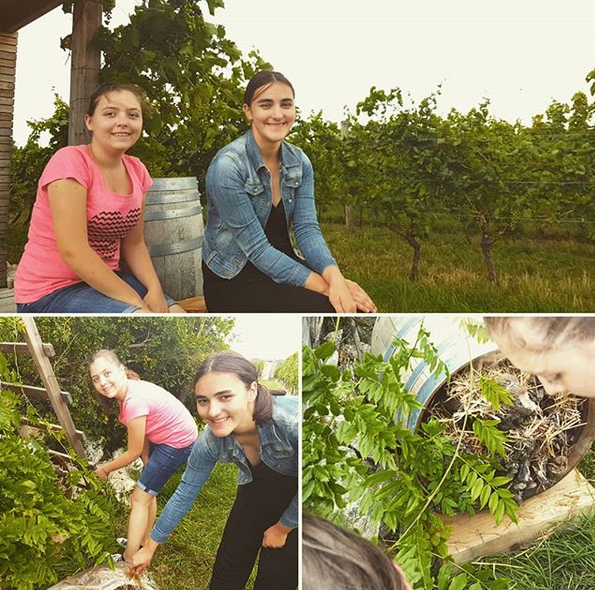
INSECT HOTEL
The picture shows Julia and our intern Linda building an insect hotel in the vineyard, a nesting aid for wild bees, bumblebees and other useful insects. A small contribution to preserve nature in all its wonderful facets!
CHICKEN HOTEL
Ten happy chickens have enriched our farm since 2010. Our younger daughter Anna gave each hen a name. They deliver fresh organic quality eggs for us and our guests every day. A delight for the palate.


The Blaufränkisch
Origin
The origin of the Blaufränkisch variety probably dates back to the 10th century. Emperor Charlemagne (742-814) carried out numerous reforms in his empire. What is less well known is that he also reformed viticulture. Among other things, he ordered a selection of the grape varieties. Inferior ones, which were referred to as “Hunnisch” or “Heunisch” because they came from Eastern countries with low vines, he had sorted out. The more valuable vines were equated with the French varieties and called “Franconian”. In any case, Blaufränkisch has nothing to do with Franconia, where the variety is not represented. Rather, it is the result of a positive grape selection of domestic and Franconian red wine varieties, which may have already come to Austria towards the end of the 10th century. Who the parents are, however, is not known. Written references to the variety can be found in Austria from the early 18th century. At that time there was still talk of the “Black Franconian”. In Slovakia and the Czech Republic it is called Frankovka, Kékfrankos in Hungary, Crna Francova in Croatia, Franconia in Italy. In the middle of the 19th century, the variety also became indigenous to Germany under the name Limberger or Lemberger. Both names refer to an old Austrian ancestry. From Lemberg in Lower Styria (Slovenia), Blaufränkisch was exported to Germany as Lemberg tannins in 1877. The second name refers to the small town of Limberg near Maissau, where at the end of the 19th century “genuine Limberger vines” were also offered for sale. The different names still hold up today, although the “Ampelografische Commission” had already fixed the name “Blaufränkisch” for this grape variety in 1875.
Taste Profile
The typical taste of a young Blaufränkisch is dominated by a strong blackberry note, but also aromas of cherries, blackberries, sour cherries, dried fruit, plums and spicy notes that are reminiscent of herbs and mint. With increasing age, the blackberry remains in the foreground, but the aromas of dried fruit and rum become stronger, as does the spicy character. Blaufränkisch has an intense, dark ruby red color.
Terroir und Climate
Blaufränkisch prefers deep, loamy soils and tolerates higher limestone contents. Blaufränkisch thrives best in warm, south-exposed locations that are sheltered from the wind, as it is a late-ripening variety. Blaufränkisch, the Riesling of the red wine varieties, becomes particularly expressive on barren soil under dry conditions. Loamy, heavy soils tend to be cooler, which is why the location and orientation of the vineyards is so important. The warm, sunny conditions at the end of September and beginning of October are particularly important.
Health Benefits
Years of research have shown that the polyphenols and resveratrol in red wine have an antioxidant effect. These substances are particularly important with regard to cardiovascular diseases and cancer. The highest resveratrol content in international comparison was measured in Blaufränkisch. Other polyphenols such as tyrosol and catechin are also represented in comparatively high concentrations, although the content in Blaufränkisch is higher than in Zweigelt.

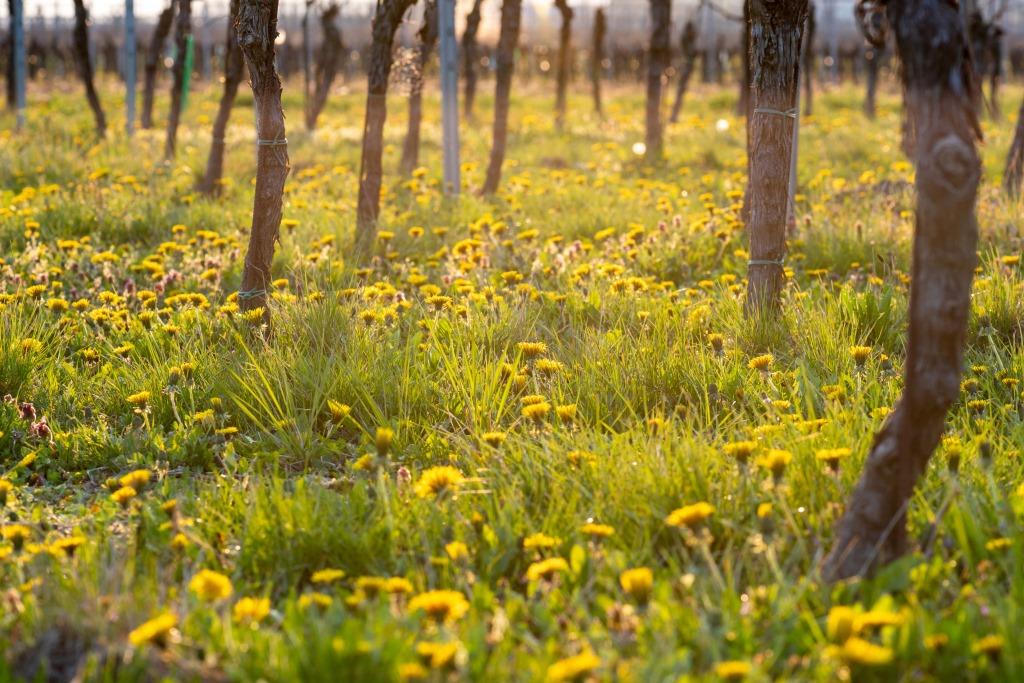
The Goldberg and its History
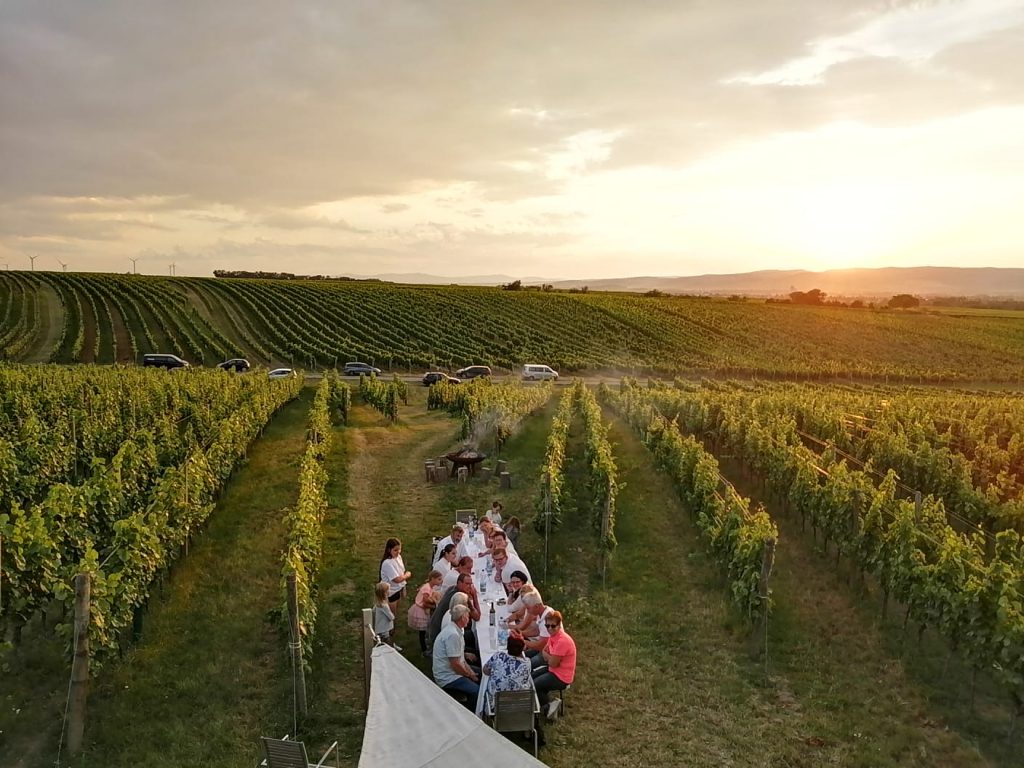
The Goldberg
It is no coincidence that our best wines come from the Goldberg vineyard, after all, it has a glorious past as a major vineyard.
Dr. Adalbert Putz, my former teacher and “studied folklorist”, who is also committed to the preservation of the local dialect, supported me in my research. The Heinrich winery cultivates eight hectares of Blaufränkisch vines on the Goldberg, three of which have been in production since 1947. Around 1920 the “Villa Goldberg” stood on the hill of the Goldberg, encircled by vines that were planted parallel to the hill, surrounded by a wrought iron fence.
The Goldberg and the Heinrich Family
My father’s great-grandparents – Theresia and Johann HEINRICH – owned a large vineyard in the Goldberg vineyard as early as the 19th century. This was passed on and was no longer in our family’s possession for a few decades. My grandparents – Rosa and Josef – helped their relatives to plant a vineyard on Goldberg when they were married in 1947. The Villa Goldberg was destroyed by the Russian occupation after World War II. Even if the place is still in the land register as a house place, we have not yet been able to rebuild the former Villa Goldberg and bring it back to life.
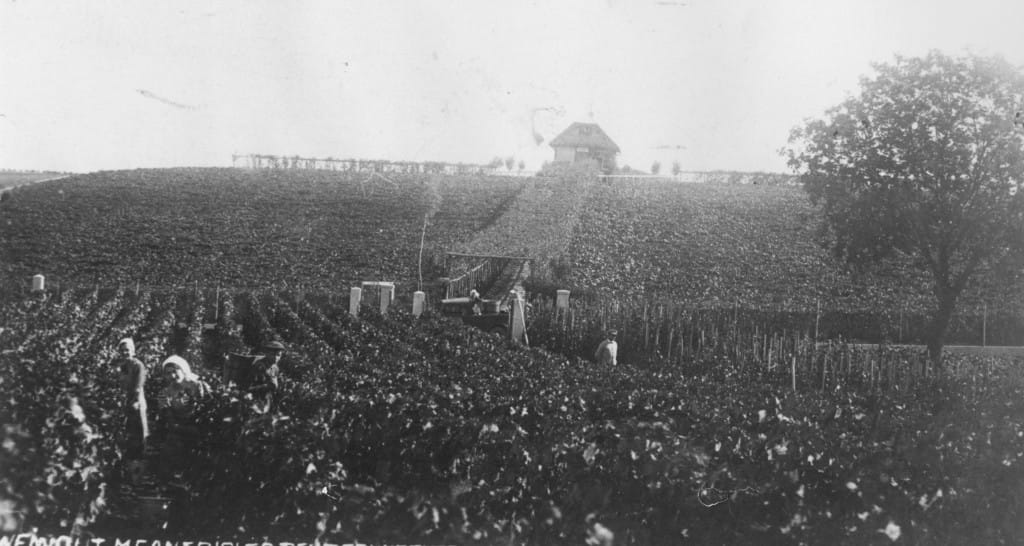
The Goldberg has always been considered the best location in Deutschkreutz and efforts were made to buy and plant vineyards there. My parents, Gerti and Johann Heinrich, bought this vineyard with three hectares of Blaufränkisch vines (back) from the related family in the spring of 1980 and wanted to clear this old vineyard in the same year after the harvest, as the hangings seemed very small. But then everything turned out differently. A trip to Bordeaux in the same year opened my parents’ eyes. There they learned that the old vines produce the best grapes and lo and behold, they wanted to know and brought in what they thought was the last harvest. But it turned out differently than planned: “The harvested grapes were unbelievably ripe and brought an unprecedented quality,” says Johann Heinrich. The vineyard was then tended and is now the heart of our house. The best Blaufränkisch grapes come from this vineyard, they are small-berried and concentrated, but very low yields.
The Goldberg and Its History
The beginnings of the Deutschkreutz viticulture undoubtedly go back much further than there are written sources. The oldest document on viticulture in Deutschkreutz dates from 1356. On June 6th of this year, the son of Count Nikolaus von Mattersdorf, the heavily indebted Nikolaus the German, pledged his estate in Chreucz to his wife Anna. Wine cultures are mentioned here, while another document from 1422 not only mentions the Deutschkreutz wine but also qualifies it. At that time, King Sigismund ordered the people of Ödenburg to have the barrels of “good wine” promised by his treasurer Stefan Kanizsay, one from Martony (Mattersdorf), the other from Kereztur (Deutschkreutz), delivered to the royal warehouse immediately.
With its approx. 290 hectares, the Deutschkreutz wine region counted as the largest one in Ödenburg County in the 18th century. It was known very early on that its location was particularly favorable for viticulture, with the south-west slopes in particular, such as Goldberg and Hochberg, being particularly mature. The elevated position of the wine cultures also largely protected the vines from freezing, which prevented years of crop failures.
In armed conflicts, Deutschkreutz was often occupied because of the wine taxes. The Lord von Baumgarten, Weytraher Martin, took possession of our congregation in 1440. On October 13th, 1442 he writes to the council of Ödenburg: “… I let you know that those from Kreutz have promised and paid homage to me and in the same homage they give me wine …” Secular and spiritual manors from Hungary, Lower Austria, Upper Austria or from Styria, such as the canons of Reichersberg in Upper Austria and Neuberg in the Mürz Valley or the Cistercians and Paulines from Wiener Neustadt, owned vineyards here. The Deutschkreutz wine was distinguished by its special shelf life and transportability.
The Goldberg is mentioned again and again in documents, the name “Goldberg” has to do with the particularly favorable location and the high quality of the grapes in this vineyard. This gentle ridge – a western slope – is hardly endangered by frost and the grapes thrive here to a high degree of ripeness. “In the Goldberg the grapes have two degrees more than anywhere else,” has been the saying among the Deutschkreutz winegrowers for generations. The Goldberg has always brought its owners an extraordinary yield: these vineyards were worth gold.
The manor also appreciated this, because in 1802 the Esterházy seem to have had the entire Goldberg in their hands. In a list of the manorial estates in Deutschkreutz, there are around ten Goldberg vineyards, which are differentiated by nicknames. Some point to those subjects who worked these vineyards in Robot, and the state of the culture is also mentioned. The last one in the list, called “Klausischer Goldberg” – today our Goldberg, says: “… carries good red Burgundy wine”, which can possibly be understood as a reference to the Blaufränkisch. The Esterházy had already planted French Burgundy vines at that time.
Addition to the “Klausischer Goldberg”, which is now in our possession and our best location: The previous owner of this vineyard was called Klaus and was a steward and cellar master in Schloss Deutschkreutz. He already owned this Goldberg around 1740. Cellar master Klaus must have understood a lot about red wine; possibly he had ties to France since his best man was French. The mentioned “Klausischer Goldberg” should have been a specialty. It was also read separately by the Esterhazy and not together like the other Goldberg systems. In 1803, Prince Nikolaus II ordered red wine growing in Deutschkreutz to be accelerated. As already mentioned, the castle winery probably had special experience in red wine production, because in 1804 the Forchtenstein cellar master was sent to Deutschkreutz to learn how to make good red wine (must fermentation, etc.).
The Esterhazy actually appreciated the Kreutz wine, because on special occasions they often had these wines served, which were also stored in the Princely Main Cellar in Donnerskirchen (“Leisserhof”). This cellar was set up in 1738 by Prince Paul Anton, following the example of the highly developed French (“welschen”) wine culture, where a “chief cellar master” took care of the best princely home-made wines as well as international wines.
Viticulture has always been of great importance for Deutschkreutz. The size of the cultivated vineyard areas varied from time to time, for example at the end of the 19th century when phylloxera caused enormous damage here too.
In the past, the Deutschkreutz wine was distinguished by its special durability and transportability, which was due to the long growing season and the late harvest. “During export tests carried out by ship via Trieste to Holland and England, Kreutzer proved in the 18th century the greatest stability of all western Hungarian wines,” the historian Dr. Harald Prickler reports. Wine has been exported to Bohemia, Moravia, Silesia and Poland from here since the Middle Ages. The local wine was later sold by the local Jewish wine merchants who had been here since the 18th century.

